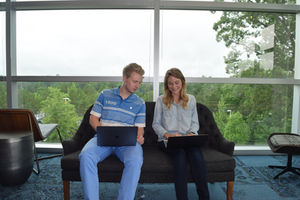How to Work Efficiently with No Desk
- Mitchell Drysdale and Madisen Andersen
- Jun 17, 2018
- 4 min read

Imagine walking into a class with no assigned seats, no defined start or end time, and no rubric for projects. Well, welcome to Cisco. Being a part of a results-oriented company allows us to form our day exactly how we want, and it is awesome. Learning how to adapt to this atmosphere can be a learning experience, so…. here’s how you can effectively work without your manager holding your hand.
1. Hold yourself to a schedule

It can be easy to slack off when your manager works across the country. No one is telling you when to come into work and no one knows when you leave for the day. Although you are not given a set schedule, we suggest that you create a schedule that works for you. If you’re not an early bird then don’t stress about coming into the office at 7am. But, consistency is a key to success. Pick a start time for your day and stick with it.
For those who have managers and teams in the same building, this strategy doesn’t necessarily change. Mapping out a schedule will allow you to be productive so that when your manager drops in on you, you’re ahead of the game.
Madisen: I personally am an early bird! I wake up everyday at 5:30am and I’m in the office by 7:45am. Getting to the office early everyday allows me to get an hour of work in before most of my friends get to work. When everyone shows up, I take a small break and catch up. I eat lunch around the same time everyday if meetings allow it, which helps me keep my day on track.
Mitchell: Every morning I wake up at 7:20, read the news for 10 minutes, then get ready for work. I leave at the same time each day and arrive at work at the same time. This allows me to keep a similar schedule each day that keeps my body and mind regular. The combination of all of that helps kickstart me in a good direction for the rest of the day.
2. Find an accountability partner

If you don’t tell anyone about your goals, nobody will be able to hold you accountable for achieving or failing. Find a coworker that you deem responsible and share your goals with them, whether they are your goals for the day, for the week, or even for a project. Set aside time with that person so that they can ask you how your progress is going, along with your goals. If you tell your plan for the day to someone else, they will expect that output from you, (hopefully) creating a need in you to meet that standard.
Madisen: You can probably guess that Mitchell is my accountability partner. I fill him in on what projects I have going on, what I need to do that day, and what I aim to accomplish that week. Doing this helps me stay on track and makes me work harder on meeting deadlines.
Mitchell: You’ll never guess who I have as my accountability partner. Yep, Madisen is the one! Whenever I walk into the office, she asks me what I have planned for the day, and that keeps me focused on the goals I have to complete before I leave. She keeps me honest and I use her as motivation to completing my tasks.
3. Know when to take a break

Many offices tend to have things you can do to get away from the daily grind - whether it’s a break room, a gym, or a place to walk (aka everywhere). Use it! If you work straight through the day, chances are you are going to burn out. Set aside time throughout the day to stand up and reenergize. It is okay to take a break from work here and there - in fact, it’s encouraged! Recognize when your mind is telling you to take break - you never know when you’ll come across a BRILLIANT idea!
Madisen: I know to take a break when I find myself rereading the same line over and over again or when I am incapable of thinking through a simple thought. When this happens, I stand up and take a lap or go and find one of my friends to annoy.
Mitchell: It is easy for me to tell when my work rate is lacking. My eyes begin to wander, and I lose focus on the tasks I am completing. Twitter, Facebook, and the news become my best friends. At this point, I realize that I need to take 5-10 minutes away from my work to get all of the procrastination out. Once I do that, I can refocus and get back to high productivity.
4. Figure out what works for you

Everybody has their own way of working effectively. Some people like sitting at a desk and not moving until their work is done and some people like to bounce around. At Cisco, you see people leaving at 1 or 2 o’clock in the afternoon because they get their work done - quick. Others like to space out their day by taking constant breaks.. So, what type is best for you? Only you can answer that question. Whatever allows you to stay healthy and happy (while meeting deadlines) is the way to go.
Madisen: I have found that moving around the office throughout the day helps me stay engaged. A change of scenery keeps me alert. I go from sitting at a communal desk with friends, to a solo standing desk, to eventually making my way into the “lounge” with the comfy chairs.
Mitchell: For me, I feel more productive when I move around from one spot to another. I struggle sometimes to get work done around others, so sometimes putting in headphones and keeping to myself allows me to finish my projects without interruption. I actually typed this section in the corner of the office by myself.
Yes, we work at Cisco and talk a lot about it, but we do because the way that employees are allowed to work, works. Giving us the ability to pick when and how to perform daily tasks keeps employees happy, which ultimately improves company retention rates.
We feel privileged and empowered by the of autonomy and unlimited resources Cisco provides. We believe this is a crucial key to their success. What works best for you? Let us know in the comments below!







Comments